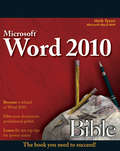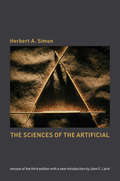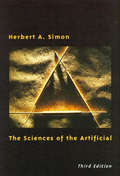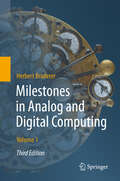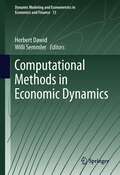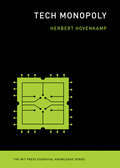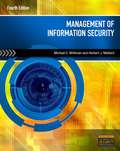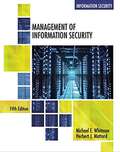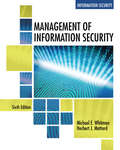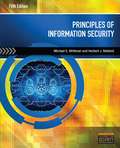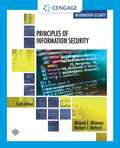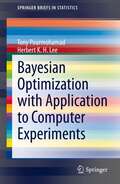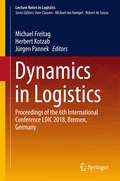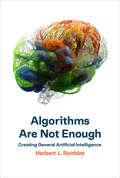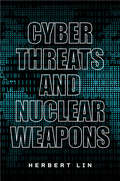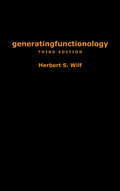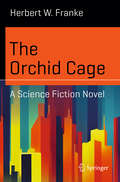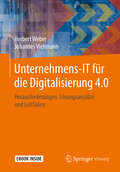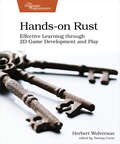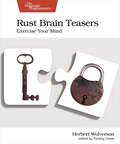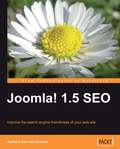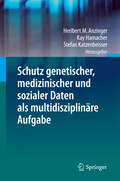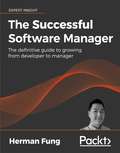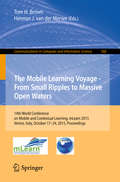- Table View
- List View
Word 2010 Bible
by Herb TysonIn-depth guidance on Word 2010 from a Microsoft MVPMicrosoft Word 2010 arrives with many changes and improvements, and this comprehensive guide from Microsoft MVP Herb Tyson is your expert, one-stop resource for it all. Master Word's new features such as a new interface and customized Ribbon, major new productivity-boosting collaboration tools, how to publish directly to blogs, how to work with XML, and much more. Follow step-by-step instructions and best practices, avoid pitfalls, discover practical workarounds, and get the very most out of your new Word 2010 with this packed guide.
The Sciences of the Artificial, reissue of the third edition with a new introduction by John Laird
by Herbert A. SimonHerbert Simon's classic work on artificial intelligence in the expanded and updated third edition from 1996, with a new introduction by John E. Laird.Herbert Simon's classic and influential The Sciences of the Artificial declares definitively that there can be a science not only of natural phenomena but also of what is artificial. Exploring the commonalities of artificial systems, including economic systems, the business firm, artificial intelligence, complex engineering projects, and social plans, Simon argues that designed systems are a valid field of study, and he proposes a science of design. For this third edition, originally published in 1996, Simon added new material that takes into account advances in cognitive psychology and the science of design while confirming and extending the book's basic thesis: that a physical symbol system has the necessary and sufficient means for intelligent action.Simon won the Nobel Prize for Economics in 1978 for his research into the decision-making process within economic organizations and the Turing Award (considered by some the computer science equivalent to the Nobel) with Allen Newell in 1975 for contributions to artificial intelligence, the psychology of human cognition, and list processing. The Sciences of the Artificial distills the essence of Simon's thought accessibly and coherently. This reissue of the third edition makes a pioneering work available to a new audience.
The Sciences of the Artificial, third edition
by Herbert A. SimonContinuing his exploration of the organization of complexity and the science of design, this new edition of Herbert Simon's classic work on artificial intelligence adds a chapter that sorts out the current themes and tools—chaos, adaptive systems, genetic algorithms—for analyzing complexity and complex systems. There are updates throughout the book as well. These take into account important advances in cognitive psychology and the science of design while confirming and extending the book's basic thesis: that a physical symbol system has the necessary and sufficient means for intelligent action. The chapter "Economic Reality" has also been revised to reflect a change in emphasis in Simon's thinking about the respective roles of organizations and markets in economic systems.
Milestones in Analog and Digital Computing
by Herbert BrudererThis Third Edition is the first English-language edition of the award-winning Meilensteine der Rechentechnik; illustrated in full color throughout in two volumes. The Third Edition is devoted to both analog and digital computing devices, as well as the world's most magnificient historical automatons and select scientific instruments (employed in astronomy, surveying, time measurement, etc.). It also features detailed instructions for analog and digital mechanical calculating machines and instruments, and is the only such historical book with comprehensive technical glossaries of terms not found in print or in online dictionaries. The book also includes a very extensive bibliography based on the literature of numerous countries around the world.Meticulously researched, the author conducted a worldwide survey of science, technology and art museums with their main holdings of analog and digital calculating and computing machines and devices, historical automatons and selected scientific instruments in order to describe a broad range of masterful technical achievements. Also covering the history of mathematics and computer science, this work documents the cultural heritage of technology as well.
Computational Methods in Economic Dynamics: Computational Methods In Economic Dynamics (Dynamic Modeling and Econometrics in Economics and Finance #13)
by Willi Semmler Herbert DawidThis volume is centered around the issue of market design and resulting market dynamics. The economic crisis of 2007-2009 has once again highlighted the importance of a proper design of market protocols and institutional details for economic dynamics and macroeconomics. Papers in this volume capture institutional details of particular markets, behavioral details of agents' decision making as well as spillovers between markets and effects to the macroeconomy. Computational methods are used to replicate and understand market dynamics emerging from interaction of heterogeneous agents, and to develop models that have predictive power for complex market dynamics. Finally treatments of overlapping generations models and differential games with heterogeneous actors are provided.
Dynamic Analysis in Complex Economic Environments: Essays in Honor of Christophe Deissenberg (Dynamic Modeling and Econometrics in Economics and Finance #26)
by Herbert Dawid Jasmina ArifovicThis book analyses decision-making in dynamic economic environments. By applying a wide range of methodological approaches, combining both analytical and computational methods, the contributors examine various aspects of optimal firm behaviour and relevant policy areas. Topics covered include optimal control, dynamic games, economic decision-making, and applications in finance and economics, as well as policy implications in areas such as pollution regulation. This book is dedicated to Christophe Deissenberg, a well-known and distinguished scholar of economic dynamics and computational economics. It appeals to academics in the areas of optimal control, dynamic games and computational economics as well as to decision-makers working in policy domains such as environmental policy.
Tech Monopoly (The MIT Press Essential Knowledge series)
by Herbert HovenkampA serious look at competition problems in tech markets and whether antitrust law can help address them.In recent years, the astronomical rise of tech giants like Amazon, Apple, Meta, and Microsoft has been criticized as anticompetitive, and many have wondered if antitrust law can help protect workers and consumers. In Tech Monopoly, Herbert Hovenkamp explores competition problems in a wide range of high-tech firms—from those that sell purely digital products, such as video streaming, search, software, or email services, to others that sell more traditional “tactile” products, such as hardware, clothing, groceries, or rides. He offers a realistic look at the powers and limitations of antitrust law in tech markets with an assessment that is as comprehensive as it is accessible.After a general introduction to antitrust law, Tech Monopoly considers how competitive harm should be assessed in these markets, as well as some features that make these markets unique, including “two-sided” structures. Then Hovenkamp looks at the role of large digital platforms, including Amazon, Alphabet, Apple, Meta, and Microsoft, and considers whether their size alone is an antitrust problem or if the concern should be limited to market power. Finally, the author addresses the very difficult problem of remedies. Should we “break up” big tech, and if so, how? What kind of breakup of these firms would make users or others better off? And if breakups are not the only possible antitrust fix, are there more effective and less disruptive alternatives?Offering simple explanations of the complex economics of digital platform markets, Tech Monopoly is an important read for anyone who wishes to understand how antitrust law works and whether it can help defend competition in the formidable era of big tech.
Management Of Information Security (Fourth Edition)
by Michael E. Whitman Herbert J. MattordMANAGEMENT OF INFORMATION SECURITY, Fourth Edition gives readers an overview of information security and assurance using both domestic and international standards, all from a management perspective. Beginning with the foundational and technical components of information security, this edition then focuses on access control models, information security governance, and information security program assessment and metrics. The Fourth Edition is revised and updated to reflect changes in the field, including the ISO 27000 series, so as to prepare readers to succeed in the workplace.
Management of Information Security
by Michael E. Whitman Herbert J. MattordDiscover a managerially-focused overview of information security with a thorough presentation of how to most effectively administer it with MANAGEMENT OF INFORMATION SECURITY, 5E. <p><p>Insightful, engaging content prepares you to become an information security management practitioner able to secure systems and networks in a world where continuously emerging threats, ever-present attacks, and the success of criminals illustrate the weaknesses in current information technologies. You'll develop both the information security skills and practical experience that organizations are looking for as they strive to ensure more secure computing environments. <p><p>This edition offers a tightened focus on key executive and managerial aspects of information security while still emphasizing the foundational material to reinforce key concepts. Updated content reflects the most recent developments in the field, including NIST, ISO, and security governance.
Management of Information Security
by Michael E. Whitman Herbert J. MattordMANAGEMENT OF INFORMATION SECURITY, Sixth Edition prepares you to become an information security management practitioner able to secure systems and networks in a world where continuously emerging threats, ever-present attacks and the success of criminals illustrate the weaknesses in current information technologies. You'll develop both the information security skills and practical experience that organizations are looking for as they strive to ensure more secure computing environments. The text focuses on key executive and managerial aspects of information security. It also integrates coverage of CISSP and CISM throughout to effectively prepare you for certification. Reflecting the most recent developments in the field, it includes the latest information on NIST, ISO and security governance as well as emerging concerns like Ransomware, Cloud Computing and the Internet of Things.
Principles of Information Security
by Michael E. Whitman Herbert J. MattordSpecifically oriented to the needs of information systems students, PRINCIPLES OF INFORMATION SECURITY, 5e delivers the latest technology and developments from the field. Taking a managerial approach, this bestseller teaches all the aspects of information security-not just the technical control perspective. It provides a broad review of the entire field of information security, background on many related elements, and enough detail to facilitate understanding of the topic. It covers the terminology of the field, the history of the discipline, and an overview of how to manage an information security program. Current and relevant, the fifth edition includes the latest practices, fresh examples, updated material on technical security controls, emerging legislative issues, new coverage of digital forensics, and hands-on application of ethical issues in IS security. It is the ultimate resource for future business decision-makers.
Principles of Information Security (MindTap Course List Series)
by Michael E. Whitman Herbert J. MattordPrinciples of Information Security, Sixth Edition, provides a broad review of the entire field of information security, background on many related elements, and enough detail to facilitate an understanding of the topic as a whole. The book covers the terminology of the field, the history of the discipline, and strategies for managing an information security program. You review terms used in the field and a history of the discipline as you learn how to manage an information security program. Current and relevant, this edition highlights the latest practices with fresh examples that explore the impact of emerging technologies, such as the Internet of Things, Cloud Computing, and DevOps. Updates address technical security controls, emerging legislative issues, digital forensics, and ethical issues in IS security, making this the ideal IS resource for business decision makers.
Bayesian Optimization with Application to Computer Experiments (SpringerBriefs in Statistics)
by Tony Pourmohamad Herbert K. H. LeeThis book introduces readers to Bayesian optimization, highlighting advances in the field and showcasing its successful applications to computer experiments. R code is available as online supplementary material for most included examples, so that readers can better comprehend and reproduce methods. Compact and accessible, the volume is broken down into four chapters. Chapter 1 introduces the reader to the topic of computer experiments; it includes a variety of examples across many industries. Chapter 2 focuses on the task of surrogate model building and contains a mix of several different surrogate models that are used in the computer modeling and machine learning communities. Chapter 3 introduces the core concepts of Bayesian optimization and discusses unconstrained optimization. Chapter 4 moves on to constrained optimization, and showcases some of the most novel methods found in the field. This will be a useful companion to researchers and practitioners working with computer experiments and computer modeling. Additionally, readers with a background in machine learning but minimal background in computer experiments will find this book an interesting case study of the applicability of Bayesian optimization outside the realm of machine learning.
Dynamics in Logistics
by Jürgen Pannek Herbert Kotzab Michael FreitagThese proceedings contain research presented at the 6th International Conference on Dynamics in Logistics, held in February 2018.The integration of dynamics within the modeling, planning and control of logistic processes and networks has shown to contribute massively to the improvement of the latter. Moreover, diversification of markets and demand has increased both the complexity and the dynamic changes of problems within the area of logistics. To cope with these challenges, it must become possible to identify, describe and analyze such process changes. Moreover, logistic processes and networks must be revised to be rapidly and flexibly adaptable to continuously changing conditions. This book presents new ideas to solve such problems, offering technological, algorithmic and conceptual improvements. It primarily addresses researchers and practitioners in the field of industrial engineering and logistics.
Algorithms Are Not Enough: Creating General Artificial Intelligence
by Herbert L. RoitblatWhy a new approach is needed in the quest for general artificial intelligence.Since the inception of artificial intelligence, we have been warned about the imminent arrival of computational systems that can replicate human thought processes. Before we know it, computers will become so intelligent that humans will be lucky to kept as pets. And yet, although artificial intelligence has become increasingly sophisticated--with such achievements as driverless cars and humanless chess-playing--computer science has not yet created general artificial intelligence. In Algorithms Are Not Enough, Herbert Roitblat explains how artificial general intelligence may be possible and why a robopocalypse is neither imminent, nor likely.
Cyber Threats and Nuclear Weapons
by Herbert LinThe technology controlling United States nuclear weapons predates the Internet. Updating the technology for the digital era is necessary, but it comes with the risk that anything digital can be hacked. Moreover, using new systems for both nuclear and non-nuclear operations will lead to levels of nuclear risk hardly imagined before. This book is the first to confront these risks comprehensively. With Cyber Threats and Nuclear Weapons, Herbert Lin provides a clear-eyed breakdown of the cyber risks to the U.S. nuclear enterprise. Featuring a series of scenarios that clarify the intersection of cyber and nuclear risk, this book guides readers through a little-understood element of the risk profile that government decision-makers should be anticipating. What might have happened if the Cuban Missile Crisis took place in the age of Twitter, with unvetted information swirling around? What if an adversary announced that malware had compromised nuclear systems, clouding the confidence of nuclear decision-makers? Cyber Threats and Nuclear Weapons, the first book to consider cyber risks across the entire nuclear enterprise, concludes with crucial advice on how government can manage the tensions between new nuclear capabilities and increasing cyber risk. This is an invaluable handbook for those ready to confront the unique challenges of cyber nuclear risk.
generatingfunctionology: Third Edition
by Herbert S. WilfGenerating functions, one of the most important tools in enumerative combinatorics, are a bridge between discrete mathematics and continuous analysis. Generating functions have numerous applications in mathematics, especially in - Combinatorics - Probability Theory - Statistics - Theory of Markov Chains - Number Theory One of the most important and relevant recent applications of combinatorics lies in the development of Internet search engines whose incredible capabilities dazzle even the mathematically trained user.
The Orchid Cage: A Science Fiction Novel (Science and Fiction)
by Herbert W. FrankeThis book is a new English translation of the classic science fiction story written in 1961 by Herbert W. Franke, widely held to be the most important German-language science-fiction writer. A dead city on a distant planet, two groups of people trying to explore it. Step by step, they penetrate the outer ring with its ultra-modern technology, the half-ruined medieval city center and finally the mysterious center. But is the eerie city really dead? Suddenly the factories start working again, the automatons intervene, and somewhere in the background there is still something hidden that could perhaps awaken. But is it people or machines? Herbert W. Franke leads the reader into an oppressively strange world; only after the startling resolution does it become clear what lies behind the adventures of the intruders - not a cosmic strangeness, but a threatening development that could affect humans in the same way. Franke's novel is thus a parable of the evolution of all humans in the age of technical communication ...
Unternehmens-IT für die Digitalisierung 4.0
by Herbert Weber Johannes ViehmannMit dem Praxisbuch bereiten die Autoren Orientierungswissen für die Modernisierung der Informations- und Kommunikations-Infrastrukturen für die Unternehmens-IT der Zukunft auf. Dazu werden die verfügbaren, schon praxisreifen neuen Technologien und deren Nutzung in ihren jeweiligen Anwendungen, aber auch Ergebnisse der Forschung und der Stand der Forschung erläutert sowie Leitfäden zur digitalen Transformation angeboten.
Hands-on Rust
by Herbert WolversonRust is an exciting new programming language combining the power of C with memory safety, fearless concurrency, and productivity boosters - and what better way to learn than by making games. Each chapter in this book presents hands-on, practical projects ranging from "Hello, World" to building a full dungeon crawler game. With this book, you'll learn game development skills applicable to other engines, including Unity and Unreal. Rust is an exciting programming language combining the power of C with memory safety, fearless concurrency, and productivity boosters. With Rust, you have a shiny new playground where your game ideas can flourish. Each chapter in this book presents hands-on, practical projects that take you on a journey from "Hello, World" to building a full dungeon crawler game. Start by setting up Rust and getting comfortable with your development environment. Learn the language basics with practical examples as you make your own version of Flappy Bird. Discover what it takes to randomly generate dungeons and populate them with monsters as you build a complete dungeon crawl game. Run game systems concurrently for high-performance and fast game-play, while retaining the ability to debug your program. Unleash your creativity with magical items, tougher monsters, and intricate dungeon design. Add layered graphics and polish your game with style. What You Need: A computer running Windows 10, Linux, or Mac OS X.A text editor, such as Visual Studio Code.A video card and drivers capable of running OpenGL 3.2.
Rust Brain Teasers: Exercise Your Mind
by Herbert WolversonThe Rust programming language is consistent and does its best to avoid surprising the programmer. Like all languages, though, Rust still has its quirks. But these quirks present a teaching opportunity. In this book, you'll work through a series of brain teasers that will challenge your understanding of Rust. By understanding the gaps in your knowledge, you can become better at what you do and avoid mistakes. Many of the teasers in this book come from the author's own experience creating software. Others derive from commonly asked questions in the Rust community. Regardless of their origin, these brain teasers are fun, and let's face it: who doesn't love a good puzzle, right? What better way to exercise your brain and increase your Rust programming knowledge than with a collection of dynamic brain teasers? As you read through each of these puzzles and try to work out the answers, you'll not only learn about Rust's unique quirks and peculiarities, you'll also have loads of fun along the way. Dive right in and get started with example code and sample problems that cover numbers and text, shadowing and memory, and everything in between. Try to figure out why a particular program won't compile, why it produces unexpected output, or why it panics and terminates with an error message. Once you've run the code and read the answer, it's time to get to the heart of the matter with a detailed explanation. Learn why a program produced the result it did, and discover how similar issues might affect the code you write in your own programs, even in production. Sourced from engaging discussions within the Rust community, real-world problems, and even reader feedback, these challenges will certainly surprise, enlighten, and entertain you. Are you ready to experience Rust like never before? Then sharpen your brain and get ready for a challenge! What You Need: This book assumes you have some knowledge of the Rust programming language. To work through the brain teasers in this book, you'll need a working Rust environment on any platform. You can install Rust by visiting https://rustup.rs/. You'll also need a text editor or Rust-friendly IDE.
Joomla! 1.5 SEO
by Herbert-Jan van DintherThis is a practical, hands-on book that will lead you through the process of search engine optimization of your Joomla!-based web site. It provides clear instructions and detailed screenshots, so you can see exactly what to do at each step in the SEO process. Once you have finished reading the book and gone through the detailed plans from each chapter, you will have the knowledge to improve the rankings and visitor numbers of almost any Joomla!-based web site. This book is written for anyone using Joomla! ranging from owners of business sites to web site developers and personal web site owners. Any Joomla! web site owner who wants to sell products or services, or send out a message to the world will find that getting better rankings in the search engines will help them reach their goal. Some prior knowledge of Joomla! is expected but no prior knowledge of search engine optimization is needed for this book. The reader will get a deeper level of knowledge on how to make their web site rank better and attract more visitors to their site.
Schutz genetischer, medizinischer und sozialer Daten als multidisziplinäre Aufgabe
by Stefan Katzenbeisser Kay Hamacher Heribert M. AnzingerFortschritte in der Medizin, in der Genomforschung und in der Informationstechnik stellen den Datenschutz vor ein Dilemma: Forschung und die Anwendung neuer Methoden setzen häufig voraus, dass personenbezogene Daten in großem Umfang zentral verfügbar, verteilbar und verknüpfbar sind. Gleichzeitig bergen zentrale Datensammlungen und die unübersehbare Weitergabe und Verknüpfung sensitiver Daten die Gefahr, dass der Einzelne auf ein Datenraster reduziert wird und Selbstbestimmungsmöglichkeiten verliert. Den Wertungskonflikten und der Schutzbedürftigkeit und Schutzfähigkeit personenbezogener genetischer, medizinischer und sozialer Daten widmete sich eine multidisziplinäre Veranstaltungsreihe des Center for Advanced Security Research Darmstadt, der Darmstädter Juristischen Gesellschaft und der Fakultät für Rechts- und Wirtschaftswissenschaften der Technischen Universität Darmstadt. Der vorliegende Band fasst die dabei entwickelten Gedanken verschiedener Wissenschaftsdisziplinen zusammen.
The Successful Software Manager: The definitive guide to growing from developer to manager
by Herman FungA developer's guide to successfully managing teams, customers, and software projects Key Features A complete guide to managing developer teams, software projects, customers, and users Transition successfully from a technical role to management Develop crucial skills to enhance your performance and advance your career Book Description The Successful Software Manager is a comprehensive and practical guide to managing software developers, software customers, and the process of deciding what software needs to be built. It explains in detail how to develop a management mindset, lead a high-performing developer team, and meet all the expectations of a good manager. The book will help you whether you've chosen to pursue a career in management or have been asked to "act up" as a manager. Whether you're a Development Manager, Product Manager, Team Leader, Solution Architect, or IT Director, this is your indispensable guide to all aspects of running your team and working within an organization and dealing with colleagues, customers, potential customers, and technologists, to ensure you build the product your organization needs. This book is the must-have authoritative guide to managing projects, managing people, and preparing yourself to be an effective manager. The intuitive real-life examples will act as a desk companion for any day-to-day challenge, and beyond that, Herman will show you how to prepare for the next stages and how to achieve career success. What you will learn Decide if moving to management is right for you Develop the skills required for management Lead and manage successful software development projects Understand the various roles in a technical team and how to manage them Motivate and mentor your team Deliver successful training and presentations Lead the design process with storyboards and personas, and validate your solution Who this book is for Development Managers, Product Managers, Team Leaders, Solution Architects, or IT Directors who want to effectively manage colleagues, customers, potential customers, and technologists.
The Mobile Learning Voyage - From Small Ripples to Massive Open Waters
by Tom H. Brown Herman J. MerweThis book constitutes the proceedings of the 14th InternationalConference on Mobile and Contextual Learning, mLearn 2015, held in a cruiseship leaving from and arriving to Venice, Italy, in October 2015. The 22 revised full papersand 6 short papers presented were carefully reviewed and selected from 81submissions. The papers deal with the topics related to the theme of theconference: "The mobile learning voyage: from small ripples to massiveopen waters". The conference theme paid tribute to the developmentsthat brought mobile learning from its infancy steps in the early 2000s tomaturity in 2015, while simultaneously paving the way for the broad andopen waters ahead with new developments and progress in mobile learning,and emerging ambient technologies.
